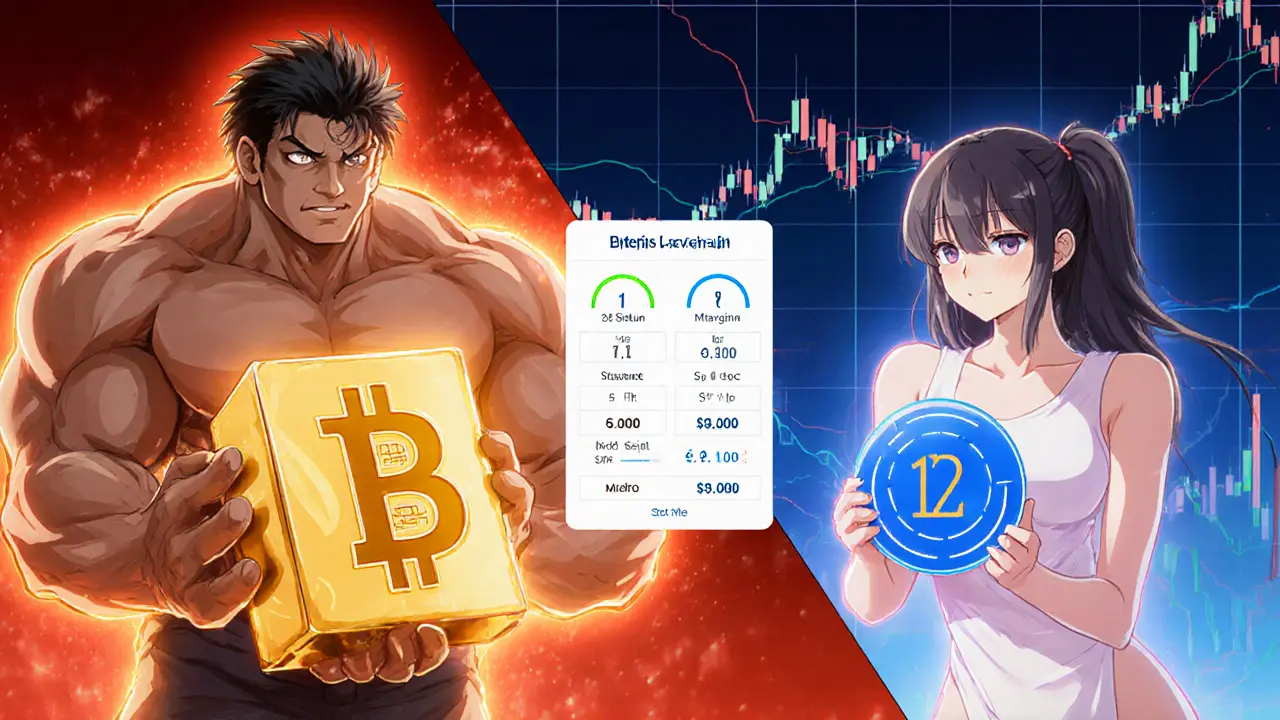Bitcoin Futures Calculator
Trade Summary
Enter values and click "Calculate Profit/Loss" to see your potential results.
Understanding Bitcoin futures is the fastest way to get exposure to Bitcoin’s price swings without actually holding the cryptocurrency. Below you’ll learn what these contracts are, how they settle, what you need to trade them, and which strategies work best.
TL;DR - Quick Takeaways
- Bitcoin futures are cash‑settled contracts that track Bitcoin’s price.
- They trade almost 24/7 on regulated exchanges like CME.
- Standard contracts equal 5BTC; micro contracts equal 0.1BTC.
- Leverage lets you control large positions with a small margin, but it magnifies losses.
- Key risks: margin calls, volatility, and contract‑specific liquidity.
What Are Bitcoin Futures?
When we talk about Bitcoin futures are cash‑settled derivative contracts that derive their value from Bitcoin’s market price, we’re describing a tool that lets traders bet on Bitcoin’s direction without buying the coin itself. Instead of delivering actual Bitcoin at expiration, the contract settles in USD based on a reference price. This eliminates the need for wallets, private keys, or worrying about exchange hacks.
Key Players and Regulation
The first regulated Bitcoin futures appeared on the Chicago Mercantile Exchange (CME) a U.S. futures exchange that launched Bitcoin futures in December2017. CME contracts fall under the oversight of the Commodity Futures Trading Commission (CFTC) the U.S. agency that regulates futures and options markets. Because of this regulatory umbrella, institutional investors can access Bitcoin exposure while staying compliant with existing financial rules.
Contract Specs: Standard vs. Micro Futures
Two main contract sizes dominate the market:
| Attribute | Standard Contract | Micro Contract |
|---|---|---|
| Contract Size | 5BTC | 0.1BTC |
| Tick Size (USD) | $5 | $0.10 |
| Initial Margin (typical) | 35% of notional | 25% of notional |
| Ideal for | Institutional traders, hedge funds | Retail traders, beginners |
Both contracts settle on the same reference price, but the micro version lets you dip your toe in with far less capital.
How Settlement and Pricing Work
Every Bitcoin futures contract uses the CME CF Bitcoin Reference Rate (BRR) an index that averages Bitcoin prices from several major exchanges over a specific window. When a contract expires-usually on the last Friday of the month-the BRR becomes the settlement price. If you entered a contract at $30,000 and the BRR closes at $31,000, you receive the $1,000 difference per Bitcoin (or per contract fraction). Because settlement is cash‑based, no actual Bitcoin moves hands.

Trading Mechanics: Leverage, Margin, and Positions
Leverage is the main attraction. With a 5% margin requirement, a $100,000 account can control a $2million Bitcoin exposure. You can go long (bet the price will rise) or short (bet it will fall). The broker holds an initial margin and a lower maintenance margin; if your equity drops below the maintenance level, you’ll receive a margin call and may be forced to liquidate.
Most brokers quote “initial margin” as a percentage of the contract’s notional value. For a standard contract (5BTC) at $30,000 per BTC, the notional is $150,000; a 35% margin means you need $52,500 upfront. Micro contracts shrink that amount proportionally, making them accessible to traders with $2,000‑$5,000 accounts.
Common Strategies in Bitcoin Futures
1. Directional Bet: Simple long or short based on market outlook. 2. Spread Trading: Buy a near‑month contract and sell a far‑month contract to profit from the shape of the futures curve (contango or backwardation). 3. Basis Trade: Exploit price differences between the futures price and the spot Bitcoin price; the goal is to capture the “basis” as it narrows. 4. Hedging: If you own spot Bitcoin, short a futures contract to lock in current value and protect against a downside move. 5. Options Overlay: Pair futures with Bitcoin options (available on platforms like Deribit) to create protected upside or downside strategies.
Platforms such as Deribit a crypto‑derivatives exchange that dominates the Bitcoin options market and tastytrade an online brokerage that offers CME Bitcoin futures with transparent fees provide the tools needed for these tactics.
Risks and Risk Management Tips
Leverage amplifies both profit and loss. A 5% move against a 10x‑leveraged position wipes out your margin. Keep position sizes small (no more than 2% of total equity per trade) and set stop‑loss orders at the outset.
Watch for “contango” (futures price above spot) and “backwardation” (futures price below spot). Rolling contracts in a contango market can eat into returns, while backwardation can boost them.
Liquidity can dry up for out‑of‑the‑money contracts, especially during market crashes. Stick to the most liquid months (the front two months) and monitor the bid‑ask spread.
Choosing a Platform and Getting Started
When selecting a broker, consider:
- Regulatory status - CME‑linked brokers are regulated by the CFTC.
- Margin requirements - some platforms offer lower initial margins for micro contracts.
- Trading hours - most futures trade almost 24hours, but a brief daily maintenance window exists.
- Fee structure - look for transparent commission and exchange fees.
Popular choices include:
- tastytrade: Direct access to CME standard and micro contracts, low commissions.
- NinjaTrader: Advanced charting, algorithmic support, and CME futures connectivity.
- Kraken Derivatives US: Offers CME contracts to U.S. residents, with NinjaTrader Clearing LLC as the clearinghouse.
- Deribit: Pure crypto‑derivatives exchange, up to 50x leverage, and a deep options market.
Open an account, complete KYC, fund it, and then you can place your first order: select contract type, decide long or short, set leverage, and submit a limit or market order.
Putting It All Together - A Sample Trade
Imagine Bitcoin is trading at $31,500. You think the price will rise over the next week. You decide to go long a micro contract (0.1BTC) with 10x leverage. The notional value is $3,150. The broker requires a 10% initial margin, so you put down $315. Your stop‑loss is set at $30,000 (a $150 drop). If Bitcoin hits $33,000, your contract gains $150 (5% of notional). After fees, you walk away with roughly $150 profit on a $315 margin - a 48% return in a week, but remember the same move down would have erased your capital.
Future Outlook for Bitcoin Futures
The market keeps expanding. New products like weekly contracts, tighter spreads, and even CME‑type Ethereum futures are on the horizon. Institutional money keeps flowing, pushing open interest past $10billion on a regular basis. As regulators fine‑tune rules, Bitcoin futures will likely stay the bridge between traditional finance and crypto.

Frequently Asked Questions
Do I need to own Bitcoin to trade Bitcoin futures?
No. Futures are cash‑settled, so you never have to buy or store actual Bitcoin. You only need a margin‑eligible brokerage account.
What is the difference between a standard and a micro Bitcoin future?
A standard contract equals 5BTC, while a micro contract equals 0.1BTC. The micro contract costs about 1/50th of the standard, making it suitable for retail traders.
How is the settlement price calculated?
CME uses the Bitcoin Reference Rate (BRR), which aggregates prices from several major exchanges over a specified time window. That BRR becomes the final settlement price on expiration.
Can I short Bitcoin using futures?
Yes. One of the biggest advantages of futures is the ability to take a short position, allowing you to profit when Bitcoin’s price falls.
What are the main risks I should watch?
Key risks include leverage‑driven losses, rapid margin calls, liquidity crunches in off‑peak contracts, and curve‑related costs when rolling positions.

Richard Herman
May 1, 2025 AT 12:46Bitcoin futures give you a way to play the price swings without lugging around actual coins, which can be a relief for anyone worried about wallets and hacks. The cash‑settlement model means you settle in USD, so you don't have to worry about custody. It's also a bridge for traditional finance folks who want crypto exposure in a regulated setting.
Parker Dixon
May 6, 2025 AT 22:35👍 Yep, the leverage part is the real double‑edged sword – it can amplify gains but also wipe you out in a heartbeat. Keep an eye on your margin ratio; once it dips below the maintenance level you’ll get a margin call. Setting stop‑losses right from the start is a habit that saves a lot of sleepless nights. And remember, micro contracts let you test the waters with just a few hundred dollars.
Stefano Benny
May 12, 2025 AT 08:23Sure, the article glosses over the fact that futures are just sophisticated bets, not actual ownership. If the market flips, your notional exposure can skyrocket beyond your initial intuition. Always calculate the implied volatility before pulling the trigger.
Bobby Ferew
May 17, 2025 AT 18:12While futures sound convenient, they also hide the raw volatility that makes Bitcoin so unpredictable. The cash‑settlement removes the need for custody, but it also disconnects you from the actual asset's network effects.
celester Johnson
May 23, 2025 AT 04:01One might argue that the allure of futures is less about utility and more about the psychological comfort of holding a paper contract. The abstraction of value into a numeric settlement can be seen as a modern reinterpretation of ancient speculative rituals.
Mark Camden
May 28, 2025 AT 13:50It is imperative to understand that leveraging a speculative instrument without a solid risk framework is ethically questionable. Traders should prioritize capital preservation over chasing marginal returns, especially in an asset class as volatile as Bitcoin.
Courtney Winq-Microblading
June 2, 2025 AT 23:38Trading Bitcoin futures can feel like stepping onto a high‑speed treadmill; you’re constantly adjusting to keep your balance. First, recognize that the contract size dictates your exposure – a standard contract represents five whole Bitcoins, which translates to a massive notional value even at modest price levels. Second, the margin requirement is the gatekeeper; you must post a percentage of that notional as collateral, and this percentage varies between standard and micro contracts. Third, leverage acts as a magnifying glass for both profit and loss, so a 10x lever can turn a 5% price move into a 50% swing in your equity. Fourth, always set a stop‑loss before you enter the trade; this simple precaution can prevent a small misstep from becoming a catastrophic wipe‑out. Fifth, monitor the CME Bitcoin Reference Rate (BRR) because it forms the basis for settlement and can differ slightly from spot prices on major exchanges. Sixth, be mindful of the contract’s expiry date – rolling over positions in a contango environment may erode returns due to higher future prices. Seventh, assess liquidity by checking the bid‑ask spread; thin spreads indicate a healthier market where you can enter and exit with minimal slippage. Eighth, diversify your exposure by using both long and short positions to hedge against market turbulence. Ninth, consider using micro contracts when you’re still learning the ropes; they let you test strategies with a fraction of the capital. Tenth, keep an eye on your maintenance margin, because a sudden price move can trigger a margin call that forces liquidation. Eleventh, remember that futures are cash‑settled, so you never actually own Bitcoin – this can be a tax advantage in certain jurisdictions. Twelfth, factor in commission and exchange fees; they may seem small per trade but add up over frequent rolling. Thirteenth, stay updated on regulatory developments; changes in CFTC oversight can impact margin requirements and contract availability. Fourteenth, use a reputable broker that offers transparent reporting and reliable margin calculations. Finally, treat each trade as a hypothesis test: define your entry, exit, and risk parameters, then evaluate the outcome objectively after the trade closes.
katie littlewood
June 8, 2025 AT 09:27Building on the thorough checklist, I’d add that psychological resilience plays a pivotal role in futures trading; the market can swing wildly, and staying disciplined is easier said than done. When you set your position size, aim for no more than two percent of your total equity per trade, as this cushions you against a string of losses. It’s also worthwhile to schedule periodic reviews of your trade journal, noting not just the numbers but the emotional state you were in at each decision point. Diversification across contract months can spread your risk, but be wary of the “roll‑over” costs that creep in when you shift from the front‑month to the next. Moreover, keep a close watch on the term structure – a steep contango might signal over‑optimism, whereas backwardation could indicate a bullish sentiment that you might want to capture. Don’t forget to factor in the latency of order execution; in fast‑moving markets, even a few seconds can make the difference between a filled order at your target price and a slippage event that erodes your expected return. Lastly, cultivate a community of fellow traders or a mentor; exchanging ideas and receiving feedback can refine your strategy and keep you from becoming siloed in your own assumptions.
Jenae Lawler
June 13, 2025 AT 19:16It would be remiss to overlook the fact that the proliferation of micro‑futures may inadvertently lower the barrier to entry for under‑capitalized participants, potentially inflating speculative bubbles. Such a development warrants scrutiny from regulators and seasoned investors alike.
Chad Fraser
June 19, 2025 AT 05:05Hey folks, if you’re feeling a bit shaky about jumping into futures, start small with a micro contract and watch how the market reacts – it’s a great way to learn without risking the house!
Jayne McCann
June 24, 2025 AT 14:53Micro contracts are perfect for a first‑time trader.
Prince Chaudhary
June 30, 2025 AT 00:42When you approach Bitcoin futures, remember that a solid understanding of contract mechanics combined with disciplined risk management is the foundation for long‑term success. Take the time to practice on a demo account before committing real capital, and you’ll build confidence gradually.
John Kinh
July 5, 2025 AT 10:31Honestly, most guides just rehash the basics and ignore the gritty reality of slippage and liquidity crunches during volatile spikes.
Evie View
July 10, 2025 AT 20:20Stop pretending futures are a “safe” playground – the leverage can obliterate you in seconds if you don’t treat it like a high‑stakes gamble and respect the math.
Sidharth Praveen
July 16, 2025 AT 06:09True, the risk is real, but with proper stop‑losses and modest position sizing you can harness the volatility for consistent, incremental gains.
Sophie Sturdevant
July 21, 2025 AT 15:57For anyone new to the space, I recommend setting up a risk‑reward ratio of at least 1:2 before entering a trade. That way, even if you’re only right half the time, your account can still grow over the long run.
Nathan Blades
July 27, 2025 AT 01:46In the grand tapestry of financial markets, Bitcoin futures are but a fleeting ripple, yet they grant us a glimpse into the collective psyche of risk‑takers. Embrace the uncertainty, but never let it consume your rational mind.
Somesh Nikam
August 1, 2025 AT 11:35Mathematically, the profit or loss of a futures position can be expressed as (ΔP / EntryPrice) × Leverage × NotionalValue, where ΔP is the price difference. Ensuring that your initial margin covers this potential exposure is essential to avoid forced liquidation.
Jan B.
August 6, 2025 AT 21:24Stick to your plan, respect the margin, and trade responsibly.